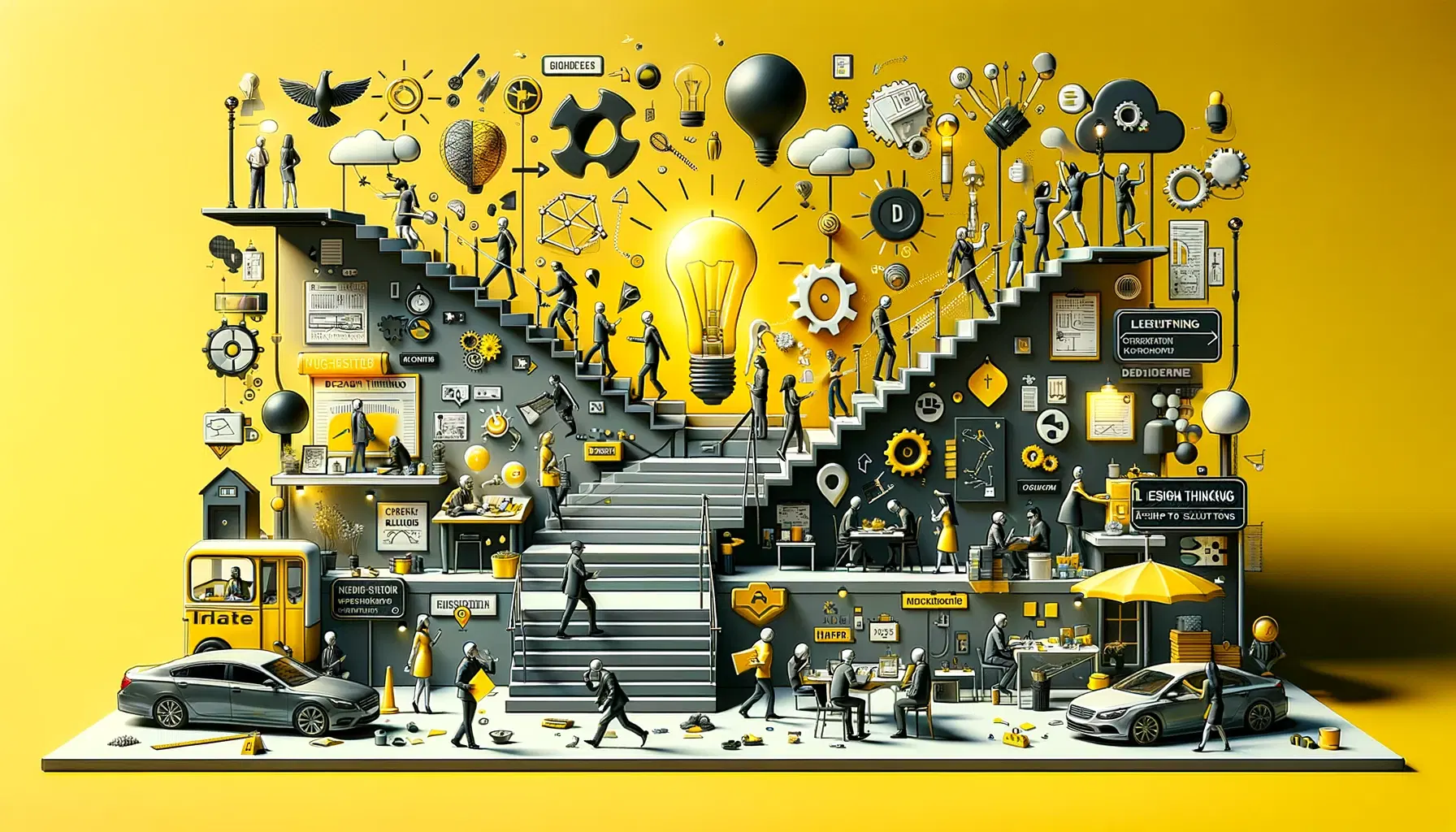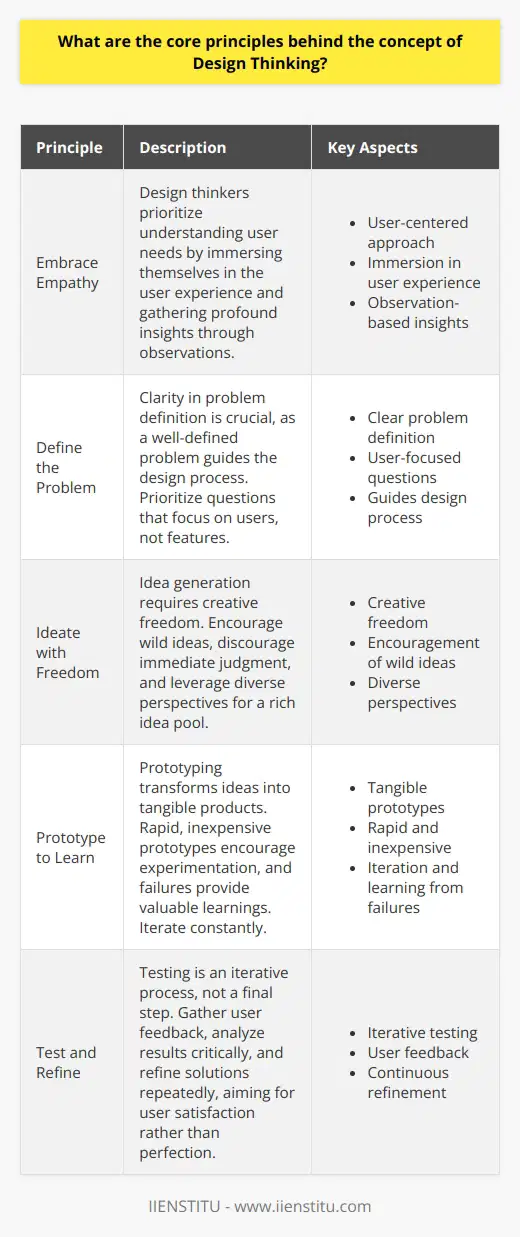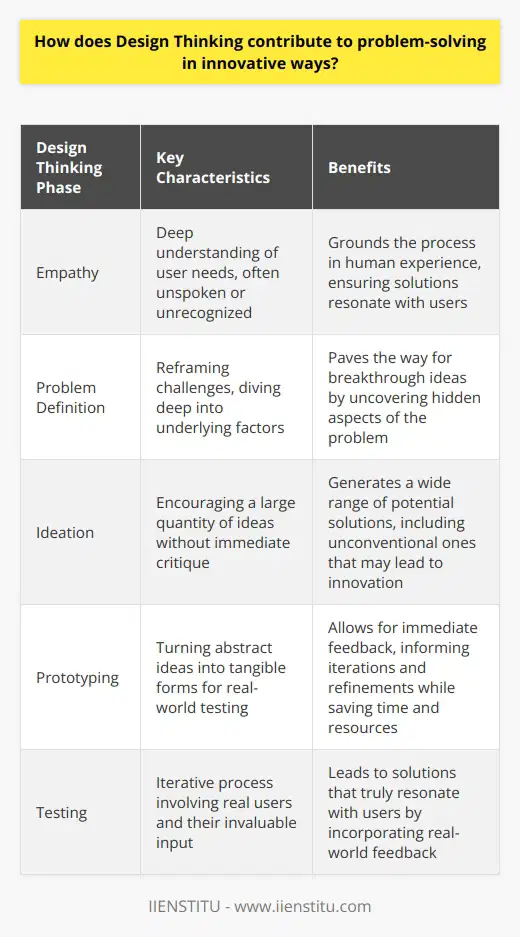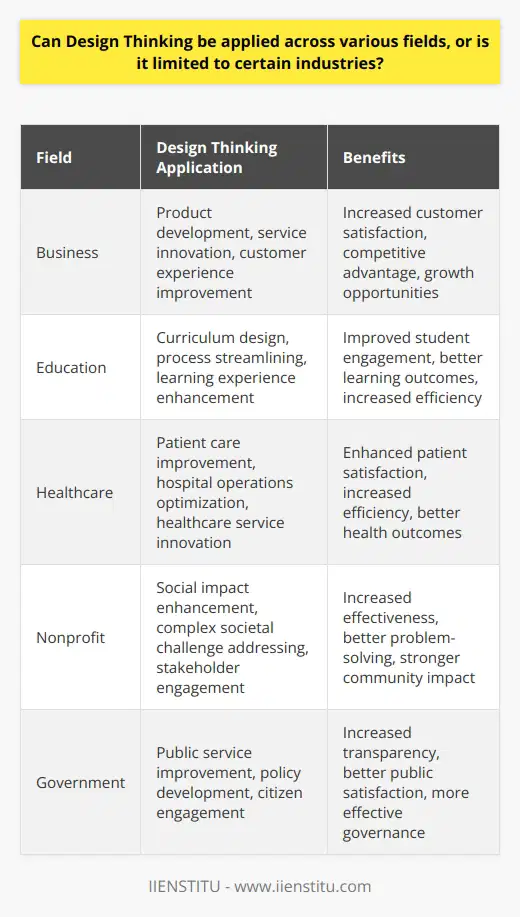
In the dynamic milieu of modern business and technology, innovation no longer stands as a mere advantage but as a necessity. Delving into this critical sphere, Design Thinking emerges as a potent methodology that transcends traditional problem-solving paradigms, offering a human-centric lens through which complex issues can be deconstructed and resolved.
As businesses and institutions advocate for a more innovative approach towards growth and development, Design Thinking provides a structured yet flexible framework that engenders creativity, drives product evolution, and enhances service delivery. The essence of this transformative process is anchored in proactive engagement with users’ needs, the creation of collaborative environments, and the iterative refinement of concepts into tangible solutions.
Introduction to Design Thinking
Definition and significance in modern problem solving
Design Thinking is an iterative process in which designers and problem solvers seek to understand the user, challenge assumptions, and redefine problems in an attempt to identify alternative strategies and solutions that might not be instantly apparent with our initial level of understanding.
At its core, Design Thinking encompasses a mindset that revolves around empathy for the user, a commitment to generating a plethora of ideas, and a willingness to engage in hands-on experimentation and prototyping. Such an approach has gradually become an indispensable component of the innovation process, enabling entities to tailor their outputs to meet the genuine demands of their target audience and to stand out in a saturated market.
Overview of Design Thinking in relation to the innovation process
The concept of Design Thinking has integrally woven itself into the fabric of the innovation process. It is an approach that combines creativity with logic, intuition with systematic reasoning and aims to produce outcomes that are not only technologically feasible and economically viable but also desirable from a user standpoint.
It emphasizes the importance of understanding consumer behavior, experimenting with solutions in real-world scenarios, and consistently iterating based on feedback. The innovation process, when viewed through the lens of Design Thinking, transforms from a linear progression into a cyclical journey of learning, ideating, and evolving.
Brief mention of the benefits of user-centered design
The benefits of user-centered design run deep into the foundation of creating products or services that resonate with users' needs and aspirations. By focusing on the users, Design Thinking champions a brand of innovation that is innately more adaptable and responsive to market changes.
Products and services that emerge from such a process are typically more accessible, intuitive, and enjoyable, leading to higher user satisfaction and loyalty. User-centered design, therefore, not only fosters innovation but also ensures that such innovation is impactful and sustainable.
Core Principles of Design Thinking
Empathy for the end-user
Empathy stands at the core of Design Thinking—it is the ability to step into the shoes of others and see the world from their perspective. This empathetic approach catalyzes a deeper understanding of the users' needs, experiences, and motivations, enabling designers to create more meaningful and personalized solutions. By actively engaging with users and empathetically processing their input, one can unearth nuanced insights that are often missed by more detached methods of research.
Iterative, non-linear progression
The iterative nature of Design Thinking acknowledges that the journey to finding the best solutions is rarely straightforward. Design thinkers iterate repeatedly—a cycle of prototyping, testing, and refining ideas. This persistence in revisiting and tweaking designs underscores a commitment to excellence and a recognition that valuable solutions are the product of ongoing effort and evolution rather than one-time inspiration.
Emphasis on diverse teams and interdisciplinary collaboration
Diverse teams bring a range of perspectives that can enhance the creative process immensely. Interdisciplinary collaboration, embraced within Design Thinking, pits varying fields of expertise against a common problem—inciting a cross-pollination of ideas that often leads to groundbreaking solutions. By gathering a heterogeneous group of individuals, every stage of the Design Thinking process is enriched with a variety of viewpoints.
Willingness to experiment and accept failure as a learning tool
In Design Thinking, failure is not a setback but a steppingstone. This outlook encourages designers to take risks and conduct experiments, leading them to unexpected avenues of innovation. Each failure sheds light on what does not work, pushing thought leaders closer to a solution that does. Hence, a willingness to fail, learn, and adapt is intrinsic to the ethos of Design Thinking.
The Five Phases of Design Thinking
Empathize: Understanding the user’s needs
Techniques for gaining insights into user experiences
Gathering deep insights into users' experiences revolves around qualitative research techniques such as interviews, shadowing, and user diaries. These techniques help in uncovering the emotional and psychological undertones of user interactions. Engaging in exercises like empathy mapping further assists in visualizing user attitudes and behaviors, paving the way for more user-aligned creations.
The role of observation and user interaction in the process
Observation and direct user interaction are pivotal in capturing the nuanced realities that users face. Through careful observation in natural settings or active involvement with the user base via participatory design, designers can acquire a comprehensive view of the challenges and aspirations of their intended audience. Such authentic engagement grounds the innovation process in the lived experiences of users.
Define: Articulating the Problem
Analyzing user feedback and data
Once insights are gathered, analyzing them to pinpoint users' true challenges is crucial. This entails scrutinizing feedback and data to discern underlying problems—sometimes those the users themselves might not be fully aware of. From this analysis, impactful issues are isolated, which become the drivers of the design process.
Crafting a clear problem statement to guide the innovation process
Establishing a clear and focused problem statement is the linchpin of Design Thinking. A well-articulated problem statement acts as a beacon, guiding all subsequent ideation and development efforts. It ensures the team aligns on the ultimate goal and shapes the direction of their creative exploration.
Ideate: Generating a Range of Creative Solutions
Introduction to various brainstorming techniques
Brainstorming stands as the crux of the ideation phase, where quantity supersedes quality—at least initially. Techniques such as mind mapping, sketches, SCAMPER, and role-playing encourage an unencumbered flow of ideas, shaking loose creative solutions. It is this phase where wild ideas are encouraged as they can lead to genuinely creative solutions.
Encouragement of wild ideas to unlock innovation
In Design Thinking, the encouragement of wild, even seemingly infeasible, ideas propels the innovation process forward. These ideas, though not always directly actionable, often ignite a spark that will eventually translate into a practical innovation.
Prototype: Building Iterative Models
The importance of creating tangible representations of ideas
Prototyping translates abstract ideas into tangible representations, enabling designers to grasp the practical aspects of their concepts. It stands as an exploratory phase where the goal is to learn and identify shortcomings of ideas in the real world. This concrete form of experimentation invites feedback and paves the way for improvement.
Approaches for rapid prototyping
Rapid prototyping is a cornerstone of an efficient iterative process. Techniques such as paper prototyping, digital mockups, and 3D printing allow for fast and frequent cycles of creation and revision. This approach serves to quickly evaluate and refine concepts before excessive resources are committed.
Test: Refining the Solution
Strategies for effective user testing
User testing involves real users engaging with prototypes, aiming to identify any practical difficulties or design oversights. Strategies like A/B testing, usability studies, and heuristic evaluations provide valuable insights into how real users interact with the product or service, offering a reality check against designers' assumptions.
Making improvements based on feedback
Feedback gathered during testing fuels further iterations. Designers must remain agile, discerning which feedback to incorporate and how to modify their designs to better serve the user's needs. The cycle of testing and refining continues until a satisfactory level of user experience is achieved.
Implementing Design Thinking in Different Contexts
Case studies showcasing successful application across industries
Design Thinking has proven to be universally applicable across various industries and domains. Case studies from tech startups, healthcare, education, and even government agencies illustrate the transformative power of this approach. These narratives not only inspire but also provide tangible strategies for integrating the process into different operational frameworks.
Adapting the framework for non-traditional settings
Design Thinking is equally applicable in non-traditional settings, including social enterprises and non-profit organizations. The key lies in adapting the framework to the unique constraints and objectives of each context. By maintaining the core principles of empathy, collaboration, and iterative learning, Design Thinking can foster innovation in virtually any environment.
Overcoming Common Challenges in the Design Thinking Process
Resistance to culture change within organizations
Institutional resistance often presents a formidable barrier to the adoption of Design Thinking. Traditional organizational cultures may not readily embrace the fluidity and openness inherent in the Design Thinking approach. Overcoming this resistance requires deliberate efforts to educate, build buy-in at all levels, and showcase the tangible benefits of a user-centered approach.
Navigating resource constraints and time limitations
Organizations also commonly face practical limitations such as resource constraints and pressing time frames. To navigate these challenges, Design Thinking advocates for prioritizing the most critical user needs and employing rapid prototyping techniques to maximize learning within limited windows of opportunity. This pragmatic methodology can yield substantial benefits despite such constraints.
Balancing the creative process with practical constraints
Melding the creative latitude of Design Thinking with the practicalities of business and technological feasibility is often an intricate dance. However, by erecting an iterative loop where each cycle constrains the solution space slightly further, teams can steadily hone in on solutions that are imaginative, achievable, and profitable.
Future Directions of Design Thinking and Innovation
Evolution of Design Thinking with emerging technologies
Emerging technologies such as artificial intelligence, virtual reality, and the Internet of Things present new avenues for the application of Design Thinking. These tools can augment the process, providing more immersive user experiences and richer data insights, ultimately elevating the quality and impact of innovative solutions.
The growing importance of sustainability and social impact in design decisions
In an era increasingly focused on sustainability and social responsibility, Design Thinking is evolving to embed these values into the innovation cycle. Designers are now tasked with envisioning solutions that not only deliver user satisfaction but also contribute positively to social and environmental well-being.
Recap of Design Thinking as a path to innovative solutions
Design Thinking provides a structured yet elastic approach that aids in circumventing traditional roadblocks to innovation. By systematically applying this philosophy, organizations and individuals can not only solve problems more effectively but can also imbue their solutions with a depth of human understanding that resonates with end-users.
The ongoing need for a user-centered approach in problem solving
The relentless pursuit of user-centricity remains at the heart of all innovative endeavors. As the world becomes increasingly complex, the design thinking methodology shines as a beacon, guiding us toward solutions that are not only viable and desirable but also deeply rooted in empathy and human experience.
Invitation to embrace Design Thinking in personal and professional endeavors
A call to action extends to all thinkers, makers, and leaders: embrace Design Thinking in your work and life. It is an approach that transcends mere methodology, becoming a philosophy that enriches how we interact with the world. Whether through formal opportunities like a problem solving course free of charge or an online mba course, or through self-guided inquiry and practice, engaging with Design Thinking opens up a spectrum of possibilities for innovation and growth.
Frequently Asked Questions
What are the core principles behind the concept of Design Thinking?
Understanding Design Thinking
Design Thinking stands as an approach to problem-solving. It prioritizes human-centered design. This methodology fosters a blend of practicality and creativity. It is applicable across various disciplines, not limited to traditional design domains.
Embrace Empathy
Empathy forms the foundation. Design thinkers prioritize understanding user needs. They immerse themselves in the user experience. Observations gather profound insights.
Define the Problem
Clarity in problem definition is crucial. A well-defined problem guides the design process. Prioritize questions that focus on users, not features.
Ideate with Freedom
Idea generation requires creative freedom. Encourage wild ideas. Discourage immediate judgment. Diverse perspectives contribute to rich idea pools.
Prototype to Learn
Prototyping transforms ideas into tangible products. Rapid, inexpensive prototypes work best. They encourage experimentation. Failures provide valuable learnings. Iterate constantly.
Test and Refine
Testing is iterative, not a final step. Gather user feedback. Analyze results critically. Refine solutions repeatedly. Aim for user satisfaction, not perfection.
Design Thinking is innately collaborative. Multidisciplinary teams often work best. Sharing knowledge and skills enhances solutions.
The Iterative Nature of Design Thinking
Iteration dominates Design Thinking. Do not fear redefining the problem. Iteration encourages depth in understanding. It surfaces more effective solutions.
The curriculum for learning Design Thinking must reflect these principles. Students should engage actively with each step. Live projects enhance learning experiences.
Conclusion
Design Thinking champions a human-first approach. Its core principles promote innovative solutions. This process thrives on empathy, ideation, prototyping, and testing. It is inherently iterative and collaborative. Through these principles, Design Thinking transforms challenges into opportunities.

How does Design Thinking contribute to problem-solving in innovative ways?
Design Thinking: A Paradigm for Innovation
Design Thinking offers a unique approach to problem-solving. It relies on deep empathy for users. This empathy shapes the creation of solutions. It starts with understanding user needs. Often, these are unspoken or even unrecognized.
Empathy: The Heart of Design Thinking
Empathy remains central to Design Thinking. It grounds the process in human experience. We often overlook this crucial aspect. Design Thinking ensures it takes front stage. By embracing empathy, we discover what really matters to people.
Defining Problems Creatively
Problem definition is key. It is not superficial. It dives deep and reframes challenges. Traditional problem-solving may miss hidden factors. Design Thinking does not. It paves the way for breakthrough ideas.
Ideation: From Quantity to Quality
Ideation comes next. It encourages many ideas. There is no immediate critique. Quantity breeds quality in this phase. Even wild ideas are welcome. They may lead to innovative solutions.
Prototyping: Learning by Doing
Prototypes follow ideation. They turn abstract ideas into tangible forms. This allows for real-world testing. Feedback becomes immediate. It informs iterations and refinements. Rapid prototyping saves time and resources.
Testing: Iteration Breeds Perfection
Testing is iterative. It involves real users. Their input is invaluable. Design Thinking values this real-world feedback. It leads to solutions that truly resonate.
Collaboration: A Multi-Disciplinary Approach
Design Thinking thrives on collaboration. Diverse perspectives converge. They create a rich understanding of challenges. The cross-functional teams challenge assumptions. This collaboration uncovers innovative solutions.
Systems Thinking: Beyond the Immediate
Design Thinking adopts systems thinking. It looks beyond immediate problems. It considers broader impacts and contexts. This holistic view uncovers sustainable solutions.
Resilience: Learning from Failure
Resilience is fundamental. Design thinkers do not fear failure. They learn from it. Iterations offer new insights. They drive the process forward.
In conclusion, Design Thinking offers a structured framework for innovation. It is human-centered, collaborative, and iterative. It transforms problem-solving into an exploratory and creative process. This generates solutions that are both innovative and practical. Design Thinking not only addresses current challenges but also anticipates future needs. This makes the approach invaluable in a constantly evolving landscape.

Can Design Thinking be applied across various fields, or is it limited to certain industries?
Design Thinking: A Universal Tool?
Design thinking offers an approach to problem-solving. It remains industry-agnostic. Critics once considered it niche. Now, leading organizations adopt it widely. It transcends traditional boundaries, making it versatile. Its process appeals to many, regardless of field.
Core Principles Adapt
Design thinking involves empathy, ideation, and prototyping. These principles guide diverse challenges. From healthcare to education, principles adapt. Each industry benefits differently. Customization is key. Design thinking molds to unique industry needs.
Empathy plays a central role. Stakeholders' needs come first. Insights drive innovation. Every field has customers. Thus, empathy's universal appeal.
Ideation fosters creative solutions. It encourages out-of-box thinking. This matters everywhere. No industry thrives on stagnation.
Prototyping tests ideas practically. Failures teach valuable lessons. Learning transcends industries. Therefore, prototyping adapts well.
Flexible and Interdisciplinary
Design thinking blends disciplines. It bridges gaps between fields. It encourages collaboration. Diverse perspectives lead to better solutions. This is true universally.
Application Examples
- Business: Companies use it for product development. They also innovate services. Design thinking improves customer experiences.
- Education: Teachers design better curricula. Administrators streamline processes.
- Healthcare: Clinicians improve patient care. They also enhance hospital operations.
- Nonprofit: Organizations bolster social impact. They address complex societal challenges.
Cultivating a Design Thinking Culture
Consistent implementation matters. Culture shift leads to innovation. Organizations must foster this environment.
Challenges and Solutions
Resistance is common. Change is hard. Leaders must encourage adaptability. Training and resources help integration.
Scaling strategies:
- Workshops train teams.
- Guidance supports application.
- Collaborative projects show benefits.
Conclusion
Design thinking is not limited. It applies across fields. It drives growth and innovation. Industries should consider it essential.



